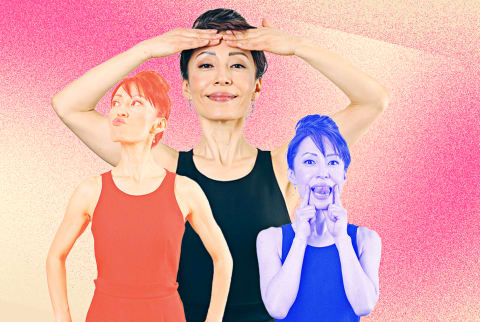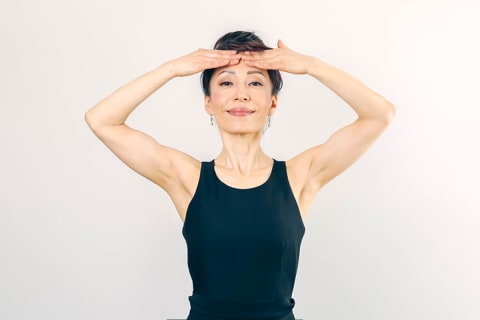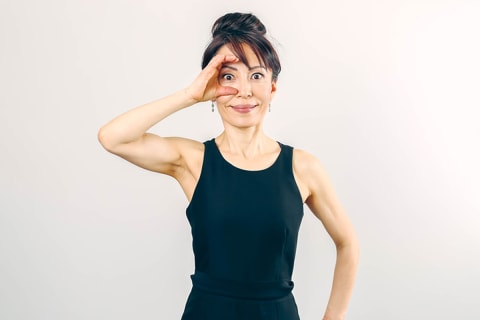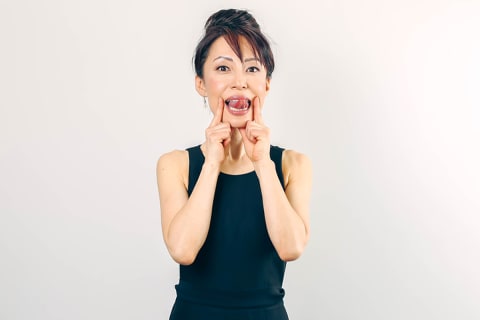Advertisement
Face Yoga Can Tone Your Muscles For Firm, Radiant Skin: Benefits + 5 Poses To Try


Did you know you can "tone" your face muscles? It's true: In the hunt for youthful and healthy-looking skin, many swear by a daily face yoga practice to carve the cheekbones, similar to how a round of squats can strengthen those glutes. Plus, the exercise can give you a plump, radiant complexion, to boot; picture that post-workout glow, only it lingers way longer than your typical hot yoga class.
It sounds too good to pass up. That's why we tapped Fumiko Takatsu, face yoga instructor and founder of the Face Yoga Method, to break down all the details of the facial exercise (plus, a few beginner-friendly poses to try). Because your jawline deserves a little toning, too.
What is face yoga?
To put it simply, face yoga is a series of facial exercises, where you intentionally isolate and tone your face muscles. We all have these tiny, delicate muscles in our face that you might not even think twice about. Take your eye area, for instance: There are over 10 muscles around our eyes constantly squinting, smiling, and expressing. "The face has muscles, just like the body," Takatsu explains. "So why not isolate and tone those muscles, relaxing the rest so you can get results?"
Of course, you move your face every day (smiling, chatting, and the like). But the kicker here is intention; like a yoga flow, you're focusing on specific muscles, strengthening them as you isolate the movement. "So many muscles are all connected; you just have to know which muscles you're using and how you want to move your muscles in a certain way."
What are the benefits?
Face yoga's main praise is its effects on the skin's appearance—namely, tightening the skin and keeping it plump. By stimulating the blood flow in your face, the circulation can spur the production of collagen (which as we know keeps your skin looking firm and taut) and delay the appearance of fine lines and wrinkles. One 2018 study even found that the daily exercise could reduce signs of facial aging1, with improvements especially in upper and lower cheek fullness.
You might be thinking: Isn't constantly moving your face what causes those wrinkles? And you're right—we emote quite a bit throughout the day, making the face a vulnerable spot for fine lines. But by intentionally toning those facial muscles, you can promote blood circulation in the skin and actually help tighten the area. "You're not causing any unwanted wrinkles because you're controlling the movement," says Takatsu.
Even more so, the practice helps you become aware of those unconscious expressions you might not think twice about (like, say, a furrowed brow as you slouch over your desk). "I truly believe 20% of the benefits is the exercise itself, but 80% of the results come from the fact that you're paying attention to your facial expressions throughout the day," Takatsu explains. "You catch yourself tightening your shoulders or tensing the forehead."
How to do face yoga.
Before diving into the poses, here's what you need to know:
- Ideally, Takatsu says to practice face yoga twice a day. Once in the morning to wake your face muscles up and again before bed to release all the tension you've accumulated during the day. "It can be as little as five minutes."
- In terms of how many poses per session, she notes four to five (for 30 seconds each) will do the job just fine. All you need is a quick warmup, then you're able to focus on specific muscles you want to target.
- Don't be fooled: It's hard. You might even find yourself unintentionally holding your breath or tensing up as you hold a pose. Because those facial muscles are so small and delicate, it's difficult to isolate and activate the muscle you're trying to target. That's why, Takatsu says, beginners might want to start with toning the bigger muscles first (such as the neck and forehead area) before moving to more delicate places like the eyes. She compares the process to riding a bike—it's difficult at first, but once you get used to the movement, it feels quite natural.
5 poses for beginners.
Below, a beginner-friendly face yoga flow. As Takatsu advises, we'll start with the bigger muscles first, then dive into the more delicate areas like the eyes and mouth. Friendly heads-up: During each pose, be sure to keep your posture straight, keep your chest open, and keep breathing. (It's harder than it sounds!)
The warmup.

For allover blood circulation, this is your go-to, simple pose.
- Drop your jaw as if you're yawning, feeling that sensation you're creating in the cheek area.
- Without moving your forehead, move your gaze from eye-level, all the way past your forehead to the ceiling without moving your forehead muscles.
- Hold for 10 seconds, remembering to breathe throughout.
- Repeat two times for a total of 30 seconds.
For the neck.

This pose releases tension and tones the neck area. The neck and jaw are connected by the platysma muscle, says Takatsu, so this stretch can also tone your jawline as well.
- Relaxing the shoulders, move your chin to one side, slightly up at a 45-degree angle.
- Pucker your lips into a kiss.
- Hold for 10 seconds, remembering to breathe throughout.
- Switch sides and repeat. Repeat both sides two times for a total of 30 seconds on each side.
For the forehead.

Takatsu calls this pose the "instant pick-me-up." That's because it doubles as a meditation, she explains, as you embrace the energy of your surroundings (great for a morning face yoga ritual).
- Place your fingers in a downward V-shape on the forehead, pulling up slightly.
- Keeping your shoulders relaxed and chin slightly up, breathe in and out for 10 seconds.
- Run the palms down the sides of the face, closing your eyes and reveling in the sensation.
- Repeat two times for a total of 30 seconds.
For the eyes.

To target the delicate under-eye area, this pose isolates the lower lid movement, as well as the forehead muscles. The key here, Takatsu says, is to try not to wrinkle your forehead.
- Curl your hand into a "C" shape. Place your index fingers above the eyebrow, along the upper eye bones.
- Position your thumb on the side of your nose, just above the nostril. Press your fingers downward and then sideways.
- Keeping your shoulders relaxed, open your eyes as wide as possible. Hold for five seconds, while pressing your index finger firmly into your eyebrow making sure your eyebrow and forehead don't move.
- Squint the eye five times, before closing your eyes and relaxing for a few seconds.
- Repeat two times for a total of 30 seconds. Repeat on the other side.
For the mouth.

As we know, our lips thin as we age due to a loss of collagen. This pose works to stimulate the lip barrier, for naturally full, plump lips.
- Place your index fingers on the corners of your mouth.
- Smile, showing the entire row of your front teeth. Make sure the corners of your mouth are at the same level.
- Curl your tongue up slightly, and take 5 seconds to slowly move it to one side. Take 5 seconds to move your tongue to the other side.
- Repeat two more times for a total of 30 seconds, remembering to breathe throughout.
The takeaway.
Face yoga is actually quite similar to the other types of yoga—you're toning the muscles, getting your blood flowing, and getting some meditation and breathwork in while you're at it. And just like yoga, it may take a bit of practice before you finally get the hang of the exercise. But start with these five poses—just twice a day—and you might notice some changes in your complexion. Namaste.